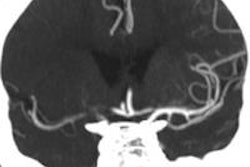
Patients' insurance status and the socioeconomic factors that may be connected to it influence the type of imaging they receive when they present with acute ischemic stroke, according to a new study published in the August issue of the American Journal of Roentgenology.
Disparities in imaging use for these patients could have negative effects, according to lead author Dr. Waleed Brinjikji, of the Mayo Clinic in Rochester, MN, and colleagues.
"[Our] findings are important because disparities in the utilization of diagnostic imaging for patients requiring hospitalization for acute ischemic stroke could potentially lead to differences in treatment options and, most importantly, outcomes," the group wrote.
 Dr. Waleed Brinjikji from the Mayo Clinic.
Dr. Waleed Brinjikji from the Mayo Clinic.The researchers used data collected by Premier insurance network to identify 210,212 inpatients with a primary diagnosis of acute ischemic stroke from November 2005 through December 2011. Patients were subdivided into four groups according to insurance status: uninsured, Medicaid, Medicare, and private insurance (AJR, August 2014, Vol. 203:2, pp. 372-376).
Brinjikji's group then compared use rates of the following:
- Head CT
- Perfusion CT
- Head MRI
- Noninvasive head angiography, including head CT angiography (CTA) and head MR angiography (MRA)
- Noninvasive neck angiography, including neck CTA and neck MRA
- Carotid ultrasound
- Echocardiography
Of the subgroups, 10,396 patients (5%) were uninsured, 14,243 (6.8%) had Medicaid, 153,209 (72.9%) had Medicare, and 32,364 (15.4%) had private insurance. The researchers found significant differences in demographic characteristics in each of the four groups: Medicare patients were older than those with private insurance, with a mean age of 77 versus 57, and patients with private insurance were more likely to be white (60%) than uninsured and Medicaid patients (44.8% and 37.7%, respectively).
Even after controlling for variables, Brinjikji and colleagues discovered considerable disparities in imaging use among the four groups. Compared with patients with private insurance, uninsured patients and Medicaid and Medicare patients had lower rates of noninvasive head angiography, noninvasive neck angiography, and head MRI.
| Variance in imaging use by insurance status | ||||
| Imaging study | % of unisured patients | % of Medicare patients | % of Medicaid patients | % of patients with private insurance |
| Noninvasive head angiography | 50.1% | 36.1% | 47.4% | 55.9% |
| Head CTA | 9.9% | 7.5% | 11.1% | 12.4% |
| Head MRA | 43.6% | 30.3% | 39.7% | 48% |
| Noninvasive neck angiography | 29.9% | 22.5% | 27.3% | 35.8% |
| Neck CTA | 9.3% | 7.5% | 10.4% | 11.6% |
| Neck MRA | 22.6% | 16% | 18.6% | 26.6% |
| Head MRI | 79.1% | 64.3% | 74.1% | 80.6% |
| Perfusion CT | 0.5% | 1% | 1.2% | 1.2% |
| Echocardiography | 80.4% | 71.9% | 77% | 81.1% |
| Carotid ultrasound | 69.8% | 65.1% | 62.2% | 65.3% |
| Head CT | 95.2% | 96.3% | 95.5% | 94.1% |
Some modalities, such as perfusion CT, were performed at similar rates across all four groups; the authors attributed this to the fact that the exam is performed in emergency departments for triage purposes, without consideration of insurance status. As for head CT, it's possible that the expertise and resources needed for these studies are available regardless of hospital setting -- i.e., rural or urban -- and it is part of routine protocol for assessing acute ischemic stroke, Brinjikji and colleagues noted.
The group also addressed the finding that carotid ultrasound was performed more often in uninsured patients than in privately insured patients, perhaps in lieu of CTA and MRA of the head and neck because it is a lower-cost exam.
Why might insurance status affect the likelihood of imaging? Perhaps low-income patients are more likely to seek care at hospitals in which expensive imaging procedures are discouraged due to financial pressures. In addition, socioeconomic status has been shown to predict when acute stroke patients arrive at the hospital, according to the authors.
"There are many factors, and all of them could be playing a role," Brinjikji told AuntMinnie.com. "One is the recognition of symptoms: Patients who are less well-insured are less likely to recognize their symptoms and get to a facility quickly. Or uninsured patients could be going to centers that perform smaller volumes of these kinds of procedures. There also could be unconscious bias from doctors toward patients who are not insured or are insured by Medicaid or Medicare."
How can these discrepancies be mitigated? Adopting appropriateness criteria is a key first step, Brinjikji said. And implementation of the Affordable Care Act (ACA) could also help.
"Following appropriateness criteria set by the American College of Radiology regarding acute stroke in the inpatient population is the good place to start," he said. "That way, imaging is applied equally, regardless of a patient's ability to pay. And it will be interesting to see if the ACA addresses these kinds of insurance-based disparities."




















